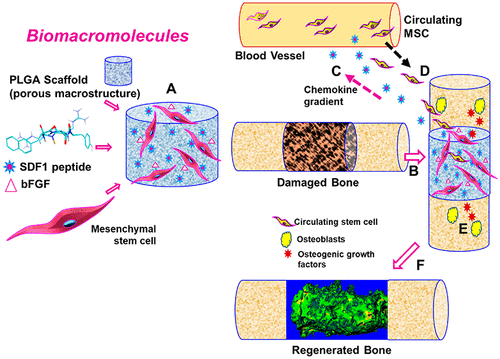当前位置:
X-MOL 学术
›
Biomacromolecules
›
论文详情
Our official English website, www.x-mol.net, welcomes your
feedback! (Note: you will need to create a separate account there.)
Chemokine SDF1 Mediated Bone Regeneration Using Biodegradable Poly(D,L-lactide-co-glycolide) 3D Scaffolds and Bone Marrow-Derived Mesenchymal Stem Cells: Implication for the Development of an “Off-the-Shelf” Pharmacologically Active Construct
Biomacromolecules ( IF 5.5 ) Pub Date : 2020-11-02 , DOI: 10.1021/acs.biomac.0c01134 Shayanti Mukherjee 1, 2 , Manish Agarwal 3, 4 , Ashish Bakshi 5, 6 , Sharada Sawant 7 , Lynda Thomas 8 , Nobutaka Fujii 9 , Prabha Nair 8 , Jyoti Kode 1, 10
Biomacromolecules ( IF 5.5 ) Pub Date : 2020-11-02 , DOI: 10.1021/acs.biomac.0c01134 Shayanti Mukherjee 1, 2 , Manish Agarwal 3, 4 , Ashish Bakshi 5, 6 , Sharada Sawant 7 , Lynda Thomas 8 , Nobutaka Fujii 9 , Prabha Nair 8 , Jyoti Kode 1, 10
Affiliation

|
There is an increasing need for bone substitutes for reconstructive orthopedic surgery following removal of bone tumors. Despite the advances in bone regeneration, the use of autologous mesenchymal stem cells (MSC) presents a significant challenge, particularly for the treatment of large bone defects in cancer patients. This study aims at developing new chemokine-based technology to generate biodegradable scaffolds that bind pharmacologically active proteins for regeneration/repair of target injured tissues in patients. Primary MSC were cultured from the uninvolved bone marrow (BM) of cancer patients and further characterized for “stemness”. Their ability to differentiate into an osteogenic lineage was studied in 2D cultures as well as on 3D macroporous PLGA scaffolds incorporated with biomacromolecules bFGF and homing factor chemokine stromal-cell derived factor-1 (SDF1). MSC from the uninvolved BM of cancer patients exhibited properties similar to that reported for MSC from BM of healthy individuals. Macroporous PLGA discs were prepared and characterized for pore size, architecture, functional groups, thermostability, and cytocompatibility by ESEM, FTIR, DSC, and CCK-8 dye proliferation assay, respectively. It was observed that the MSC+PLGA+bFGF+SDF1 construct cultured for 14 days supported significant cell growth, osteo-lineage differentiation with increased osteocalcin expression, alkaline phosphatase secretion, calcium mineralization, bone volume, and soluble IL6 compared to unseeded PLGA and PLGA+MSC, as analyzed by confocal microscopy, biochemistry, ESEM, microCT imaging, flow cytometry, and EDS. Thus, chemotactic biomacromolecule SDF1-guided tissue repair/regeneration ability of MSC from cancer patients opens up the avenues for development of “off-the-shelf” pharmacologically active construct for optimal repair of the target injured tissue in postsurgery cancer patients, bone defects, damaged bladder tissue, and radiation-induced skin/mucosal lesions.
中文翻译:

趋化因子SDF1介导的骨再生采用可生物降解聚(d,L-丙交酯-共-glycolide)三维支架和骨髓间充质干细胞:一个“关闭的,现成的”药理活性构建发展的启示
在去除骨肿瘤之后,越来越需要骨替代物用于整形外科手术。尽管骨骼再生方面取得了进步,但自体间充质干细胞(MSC)的使用仍然提出了巨大的挑战,特别是对于癌症患者的大骨缺损的治疗。这项研究旨在开发新的基于趋化因子的技术,以产生可生物降解的支架,该支架结合药理活性蛋白,用于患者靶损伤组织的再生/修复。原发性MSC是从癌症患者未受累的骨髓(BM)培养而来,并具有“干性”特征。在2D培养以及结合生物大分子bFGF和归巢因子趋化因子基质细胞衍生因子1(SDF1)的3D大孔PLGA支架上研究了它们分化为成骨细胞谱系的能力。来自癌症患者未受累BM的MSC表现出与健康人BM所报道的MSC相似的特性。制备了大孔PLGA盘片,并分别通过ESEM,FTIR,DSC和CCK-8染料增殖分析对其孔径,结构,官能团,热稳定性和细胞相容性进行了表征。观察到,培养14天的MSC + PLGA + bFGF + SDF1构建体支持显着的细胞生长,骨谱系分化以及增加的骨钙素表达,碱性磷酸酶分泌,钙矿化,骨量,通过共聚焦显微镜,生物化学,ESEM,microCT成像,流式细胞仪和EDS分析,与未接种PLGA和PLGA + MSC相比,可溶性IL6含量更高。因此,来自癌症患者的MSC的趋化性生物大分子SDF1指导的组织修复/再生能力为开发“现成的”药理活性构建物开辟了道路,以最佳地修复术后癌症患者,骨缺损,损坏的膀胱组织,以及辐射诱发的皮肤/粘膜病变。
更新日期:2020-12-14
中文翻译:

趋化因子SDF1介导的骨再生采用可生物降解聚(d,L-丙交酯-共-glycolide)三维支架和骨髓间充质干细胞:一个“关闭的,现成的”药理活性构建发展的启示
在去除骨肿瘤之后,越来越需要骨替代物用于整形外科手术。尽管骨骼再生方面取得了进步,但自体间充质干细胞(MSC)的使用仍然提出了巨大的挑战,特别是对于癌症患者的大骨缺损的治疗。这项研究旨在开发新的基于趋化因子的技术,以产生可生物降解的支架,该支架结合药理活性蛋白,用于患者靶损伤组织的再生/修复。原发性MSC是从癌症患者未受累的骨髓(BM)培养而来,并具有“干性”特征。在2D培养以及结合生物大分子bFGF和归巢因子趋化因子基质细胞衍生因子1(SDF1)的3D大孔PLGA支架上研究了它们分化为成骨细胞谱系的能力。来自癌症患者未受累BM的MSC表现出与健康人BM所报道的MSC相似的特性。制备了大孔PLGA盘片,并分别通过ESEM,FTIR,DSC和CCK-8染料增殖分析对其孔径,结构,官能团,热稳定性和细胞相容性进行了表征。观察到,培养14天的MSC + PLGA + bFGF + SDF1构建体支持显着的细胞生长,骨谱系分化以及增加的骨钙素表达,碱性磷酸酶分泌,钙矿化,骨量,通过共聚焦显微镜,生物化学,ESEM,microCT成像,流式细胞仪和EDS分析,与未接种PLGA和PLGA + MSC相比,可溶性IL6含量更高。因此,来自癌症患者的MSC的趋化性生物大分子SDF1指导的组织修复/再生能力为开发“现成的”药理活性构建物开辟了道路,以最佳地修复术后癌症患者,骨缺损,损坏的膀胱组织,以及辐射诱发的皮肤/粘膜病变。











































 京公网安备 11010802027423号
京公网安备 11010802027423号